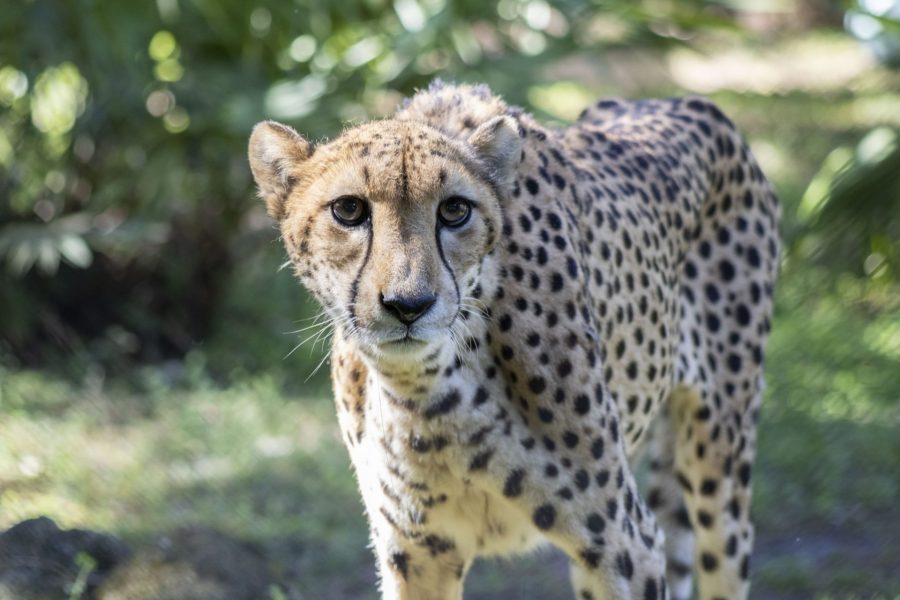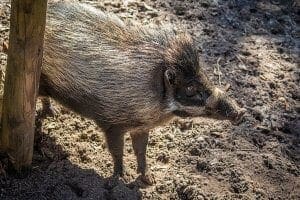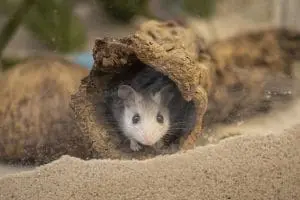

Pepper the cheetah has been with Brevard Zoo since she was 2 years old!
At our Zoo, we have enjoyed being home to many of our animals for a great number of years. Pepper the cheetah, now 13 years old, joined us as a 2-year-old. Makina and Fancy, our Visayan warty pigs, have been with us since they were each 5 and 6 – and are now 18 and 19 years old, respectively – and the oldest females in an Association of Zoos and Aquariums (AZA) facility.
 With the fun of watching our residents charm and educate guests over the years comes the privilege of caring for them as their needs change with age. In addition to listening to our keepers’ insights into their well-being, we keep an eye on our older residents’ quality of life with regular assessments. Our team conducts these assessments anytime an animal has an injury or illness; or when they reach 80 percent of their lifespan. Illnesses and injuries are easy to define, but how do we know when an animal has reached that 80 percent mark?
With the fun of watching our residents charm and educate guests over the years comes the privilege of caring for them as their needs change with age. In addition to listening to our keepers’ insights into their well-being, we keep an eye on our older residents’ quality of life with regular assessments. Our team conducts these assessments anytime an animal has an injury or illness; or when they reach 80 percent of their lifespan. Illnesses and injuries are easy to define, but how do we know when an animal has reached that 80 percent mark?
Median Life Expectancies
AZA resources and other facilities give us an idea of what age some of our animals may reach in human care. One such source, a reference library of median life expectancies, bases its insights on the ages of many species in AZA-accredited zoos and aquariums. These ages are what we reference when assessing our animals.
Median life expectancy is the age that half of a species’ population have typically already passed away. Not a cheery thought, but it gives us a better benchmark on how our animals are faring rather than looking at maximum longevity, which can set unrealistic expectations. For example, for people in the U.S., the median life expectancy is 78 years old and the maximum longevity for a human (documented worldwide) is 122.
Should we be nervous for our beloved animal residents like Pepper, who is past the median life expectancy for cheetahs (11.7 years old)? Not necessarily, said Zach Marchetti, curator of animals.
“As a veterinarian friend always says, ‘age is not a disease, it’s a risk factor,’ Zach said. “So, just because your favorite animal has reached their median life expectancy does not mean death is lurking around the corner.”
“However, it does mean that they are statistically at a higher risk of developing serious issues than their younger counterparts.”
That’s where those QLA’s come in at our Zoo. They help us assess an animal resident’s mobility, medications, diet and more. These QLA’s also help us know when an adjustment is needed to a resident’s medical treatments, habitat and more to keep them comfortable as their needs and body change with age.
The Rhyme or Reason

There are some observable trends and reasons behind why some species live longer than others, Zach said. Most creatures can be separated into two groups:
From a biological perspective, the main purpose of every organism is to reproduce and pass on their genetic material, Zach said. Quickly changing environments favor species with a shorter median life expectancy because those species – typically the r-select species – can adapt more quickly. Larger, more dominant species may need a more stable environment to provide enough quantity and consistency of food to support their longer life.
“Their lifespans are then dictated by their metabolism, which then shows how quickly their cells and bodies wear out – and the external pressures from predators, competitors, the environment, etc.,” Zach said.
According to researchers at the Santa Fe Institute, there may be an even simpler explanation behind the reason some species lives longer than others. Those researchers found that all mammals have about 1.5 billion heartbeats in a lifespan. Every species uses those heartbeats differently. Elephant shrews, for example, have a heart rate of over 1,000 beats per minute while elephants have a heart rate of about 30 beats per minute. At those different rates, the shrew will reach 1.5 billion heartbeats over 33 times faster than an elephant. This means that a shrew’s body will quite literally just wear out much faster than the elephant’s body.
“Larger animals need to have more efficient cellular systems because there is more distance for blood and neurons to travel and more things that can go wrong,” Zach said. “That greater efficiency means that their system can do things more slowly and therefore last longer.”
“‘Live fast die young’ may not be a ‘rule’ but you could certainly call it a trend within the animal kingdom.”
Factoring in Human Care
When comparing median life expectancies between animals in their natural range and in human care, animals in human care typically live longer. Animal residents don’t need to worry about being too slow to hunt, getting injured by a member of their species or being injured or killed by humans.
“Medical care is often the first reason people think of, but many animals don’t live long enough to get diseases in their natural range,” Zach said. “Medical care is certainly part of the equation, but physical protection and food availability likely play as large of a role in extending the lives of the animals in our care.”
Despite the security of living in human care, our animal residents still face the same things we all face – illness and injury. We take pride in giving our animals as many comfortable years as possible, but this also comes with the responsibility of understanding when our care is no longer benefitting them from a quality-of-life standpoint.
“Enjoy every opportunity you get to spend with your favorite zoo animals no matter their age,” Zach said. “We all know that life can change in an instant.”
Brevard Zoo is an independent, not-for-profit organization that receives no recurring government funding for our operating costs. Your generous support enables us to continue to serve our community and continue our vital animal wellness, education and conservation programs.